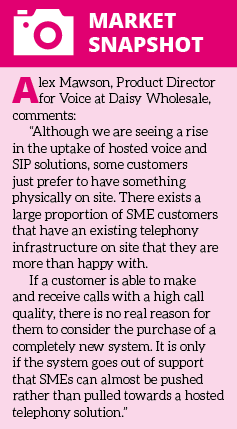
Editor Ian Hunter takes a look at the UK PBX market for what could be the last time in this format. He explains why and talks to some of the players in the newer world of communications platforms.
If I were to polarise my views on CPE based PBX into two pretty distinct markets I would describe and differentiate them as follows:
In general terms there is a market for smaller, say 10-15 extension PBX systems, that is alive and reasonably well functioning via distribution channels to resellers as it has always done. Although features are generally available on these systems they are often only sold with dial tone and a bit of voicemail.
The second market I see is that for larger systems (remember the UK average is still under 40 users) where in recent years these products have been ‘dressed up’ or ‘disguised’ by the marketing department as communications platforms, call control systems and or unified communications solutions. The amount of disguise is in direct proportion to the size of ‘the solution’.
 There are many reasons for this. Post 2008 when an aversion to CAPEX prevailed you needed a jolly good reason to kick out a perfectly functional PBX so giving it a different name helped in that process as did the emergence of unified communications – albeit there was a lot of smoke and mirrors involved as well. But that’s what marketing people get paid for n’est ce pas?
There are many reasons for this. Post 2008 when an aversion to CAPEX prevailed you needed a jolly good reason to kick out a perfectly functional PBX so giving it a different name helped in that process as did the emergence of unified communications – albeit there was a lot of smoke and mirrors involved as well. But that’s what marketing people get paid for n’est ce pas?
And of course these marketing types at PBX vendors were also having to come up with major delaying tactics while the company got their ‘cloud/hosted’ stories right. All at a time when they had almost zero development budgets because of the financial crash going on around them.
At that time the hosted telephony providers pretty much had a perfect storm for their products but somehow contrived not to put the ball in the net in sufficient numbers to emerge as league leaders. They are contenders but that’s for another time…
So why is this likely to be the last time we look at PBX in isolation? Well the evidence is here in black and white in this issue in the form of our ‘UC for the SME’ article. Take a look.
Back to CPE PBX – what are the trends in the market place?
Well according to Rob Pickering, CEO of UK based vendor ipcortex, the landscape is changing and we are seeing that where resellers are able to clearly demonstrate the value of a joined up solution to their business, end users are prepared to pay.
“ipcortex has put a lot of effort into developing systems that make it easy for resellers to show business value and differentiate themselves. For example, by making our API freely available to resellers we empower them to integrate sophisticated UC functionality with other key business systems such as CRMs. The PBX becomes an enabler - an engine - and resellers go on to make margin by connecting business processes, rather than ‘just’ selling CPE.
Our most successful resellers are taking it one step further and developing solutions tailored to specific verticals - lifting themselves out of the fiercely competitive UC space and building their business around specific added value creating additional revenue and better customer service for the end user.”
Now I’m far from saying read my paragraph above on ‘disguise’ and you can see what I mean. But can you sell a PBX as a PBX today?
Why don’t we see what a distributor says.
Cue John Mckindland, Head of Systems Sales at Nimans
“Double digit sales growth was generated here last year and we expect these trends to continue throughout 2015. CCU demand was up significantly with all of our brands. A lot of that growth was organic. We picked-up new business but had to work very hard for it. Attachment rates are key. I’m talking about CTI packages, call management, call reporting and call recording. They’ve all grown as well. All the successful resellers will sell a complete solution rather than just a PBX. This will often involve the system and handsets all on a lease with installation and maintenance included. Bundling lots of additional products and services is key to success.”
 We have to bear in mind that last year some vendors abandoned their dealer route to market in favour of distribution because they could not afford the former so it is natural for distribution sales to grow.
We have to bear in mind that last year some vendors abandoned their dealer route to market in favour of distribution because they could not afford the former so it is natural for distribution sales to grow.
So where is the market going?
Mckindland thinks the market will continue to grow but is not convinced it will be maybe as much as some optimists are suggesting over the 20% mark.
“Where we will see large growth is with attachment rates around technology such as low cost of entry video conferencing. It’s really easy to position and easy to sell. There’s no lengthy accreditation and it instantly adds value to a reseller’s proposition. Microsoft hosted Lync is another area with lots of potential. Ways to enhance productivity will always be popular. CCU growth will be healthy but it’s about adding associated technologies that will help really drive margins Wireless LAN is another major sector with massive growth expected this year.”
We tend to agree with this ‘attachment theory’ but it’s not as simple as it sounds and nor is there a simple sales strategy that will work every time – each customer is different and sales skills come in to this big time.
Distributor Westcon has always had a stronger presence in the mid-market so it was interesting to hear what Andy Herring, their EMEA Product Manager for Avaya Voice & Video Solutions, had to say.
“Westcon is currently seeing a growing trend in the mid-market and Avaya is focusing on the mid-market opportunity with the latest release of IP Office that scales up to the mid-market requirements.”
This is true; we went to the well-attended Westcon/Avaya IP Office version 9.1 last month in London where I was staggered to learn the IP Office could now handle up to 2500 users.
I was therefore not surprised to hear Andy Herring say, “This can be challenging for some of the Partners who are more traditionally focussed on the SME market who may need to skill up to take advantage of the Mid-Market opportunity.”
In an effort to get this rolling Westcon and Avaya are working closely together to inform and educate resellers through leveraging programmes such as iConnect from Avaya and Westcon’s own Activ8 programme that includes: promotions, incentives, sales and technical training, workshops and collateral such as their ever popular ‘Tell me About’ guide.
The mid-market can be a very different sell compared to more traditional SME opportunities. Understanding the customer, their business and associated challenges is key to achieving a successful sale.
Sticking with British vendors Robin Hayman, Marketing and Product Director at SpliceCom, says that his company is finding that opportunities for on-premise PBXs, be they soft, hard or virtual are now almost exclusively application led.
Hayman is often a man for all seasons and he says that hosted telephony is best suited for the simple dial-tone implementations required by very small and very large customers; those that would have been served in the past by small Key and Lamp digital systems or FeatureLine/Centrex, and large scale PBX with analogue handsets respectively. This leaves the middle ground market wide open for the on-site PBX.
Interesting point that; big PBX systems always had dumb analogue phones attached but Hayman goes on to talk attachments.
“The ease with which Mobility, Business Management and Call Recording can be deployed and used have long been deal clinchers for SpliceCom, but increasingly it’s Unified Communications, in the form of integration with core business IT applications, that we find ourselves talking about at the point-of-sale.

The modern workforce wants to drive their communications via the apps that are in constant use throughout the business, typically Personal Information Managers (PIMs) like Microsoft’s Outlook, or Customer Response Management systems like Salesforce or Microsoft Dynamics. This includes business telephony and IM in addition to email. Our channel partners are now spending more time demonstrating these capabilities, through Navigate UC and Navigate CRM, than they are handset features.”
Hayman also thinks we need to revisit old strategies when he says that the old adage of those who want to finance their equipment through CAPEX go for an on-site solution, those who want OPEX choose hosted needs revising.
“We offer a range of alternative payment plans through SpliceCom Financial Services for those who prefer to go down the OPEX route for their on-site PBX, including a three or five year Lease Rental deal and an innovative pay-as-you-go flexible licence programme.
However, it’s been interesting to see that we’re now starting to turn around business from hosted end-users who have worked out that, for all the great headline prices, they’re paying far more for a hosted solution over three or five years than an outright purchase of their own PBX.”
(We published a case study to this effect last month – Ed)
Interesting Point…
Hayman concludes by raising a concern over an issue that seems to have been largely ignored.
“One of the other areas where we’re seeing a higher PBX sales profile is in those instances where the data produced from and by the system is deemed core to the customers’ business; call recordings, call billing info and call management reports. There’s still an unanswered question of who actually owns all this data when telephony is provided as a service.
Until there’s a satisfactory answer, Call Centres, Business Centres and those who have a legal requirement to keep Call Recordings will continue with their preference to purchase an on-site solution rather than lease a service.”
What’s Selling?
We spoke to Alexis Argent, founder and director at VoIPon Solutions, who has clear views on how he sees the market.
“In the current climate we are seeing three different types of customer coming through in the PBX market. For low cost IP PBXs we are seeing customers purchasing models such as the Grandstream UCM series. They are also opting for products from the ZYCOO range which includes the ZX50 series. Low Cost IP PBXs are ideal for small and medium sized business in daily communications.”

Argent says the latest customer trends also show movement away from Cisco based solutions, such as the end of life UC300 and UC500, to Digium Switchvox and their Unified Communications Business Phone System.
“The larger projects and customers are also looking at the 3CX Phone System, a Windows based software PBX, which is experiencing some excellent growth.
The PBX is certainly not dead, however cloud or hosted based solutions are still definitely on the rise.
For small businesses, cloud or hosted PBX is an interesting opportunity. However large businesses will still want to manage their own system and I cannot see this being done by a software solution, but by an appliance, but time will tell.”
Ed Says…
Once upon a time I would have been swamped with comments for this article by the likes of Panasonic, Samsung, Toshiba, Siemens (Unify) etc. Today we are getting nothing new from these companies albeit Unify is plugging their new ways to work mantra (worth a read) but forgetting their roots and channel heritage. To be fair I would too if there was no money in it. My message if you want to sell a PBX is to buy British – at least SpliceCom and ipcortex are demonstrating healthy interest in the channel.
